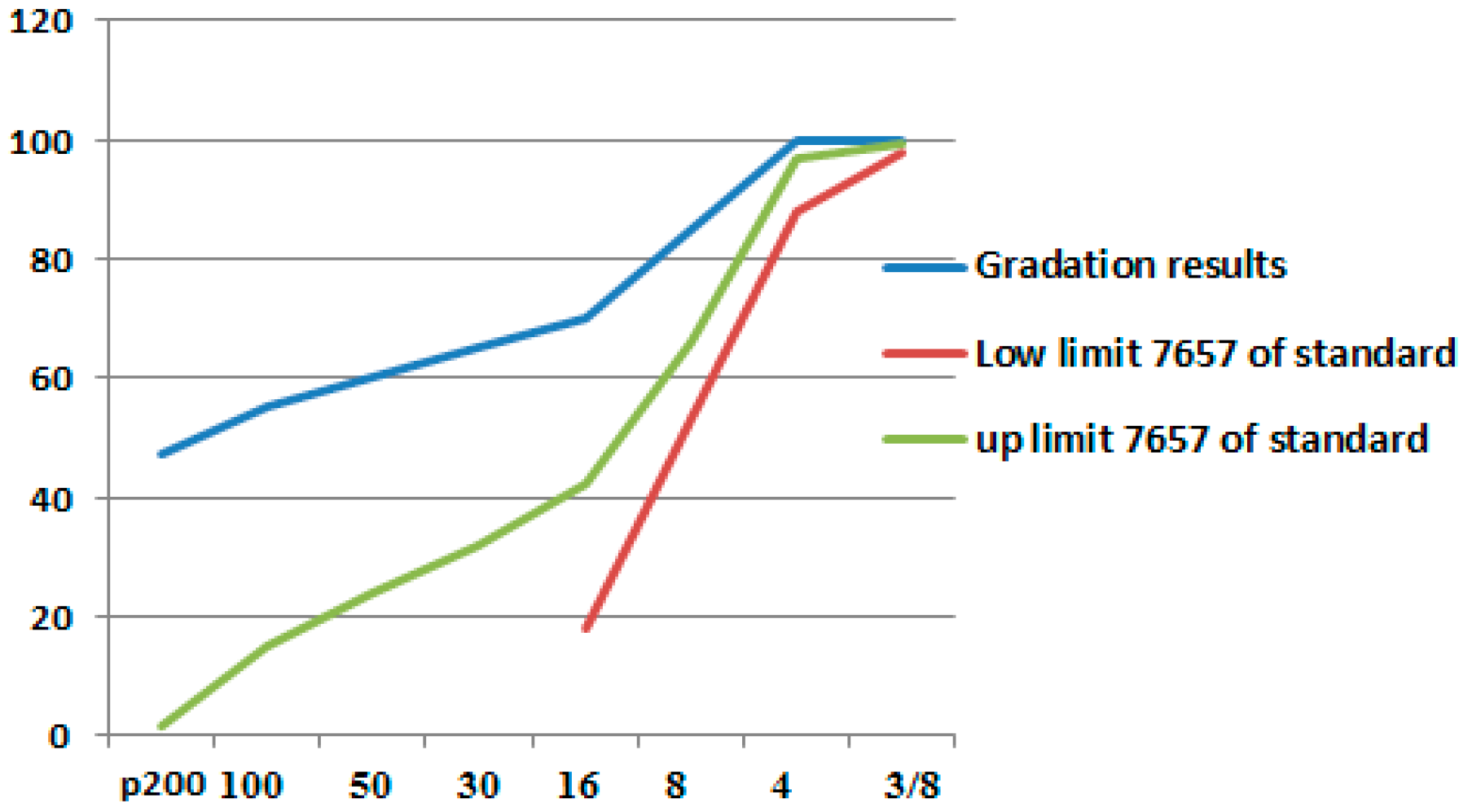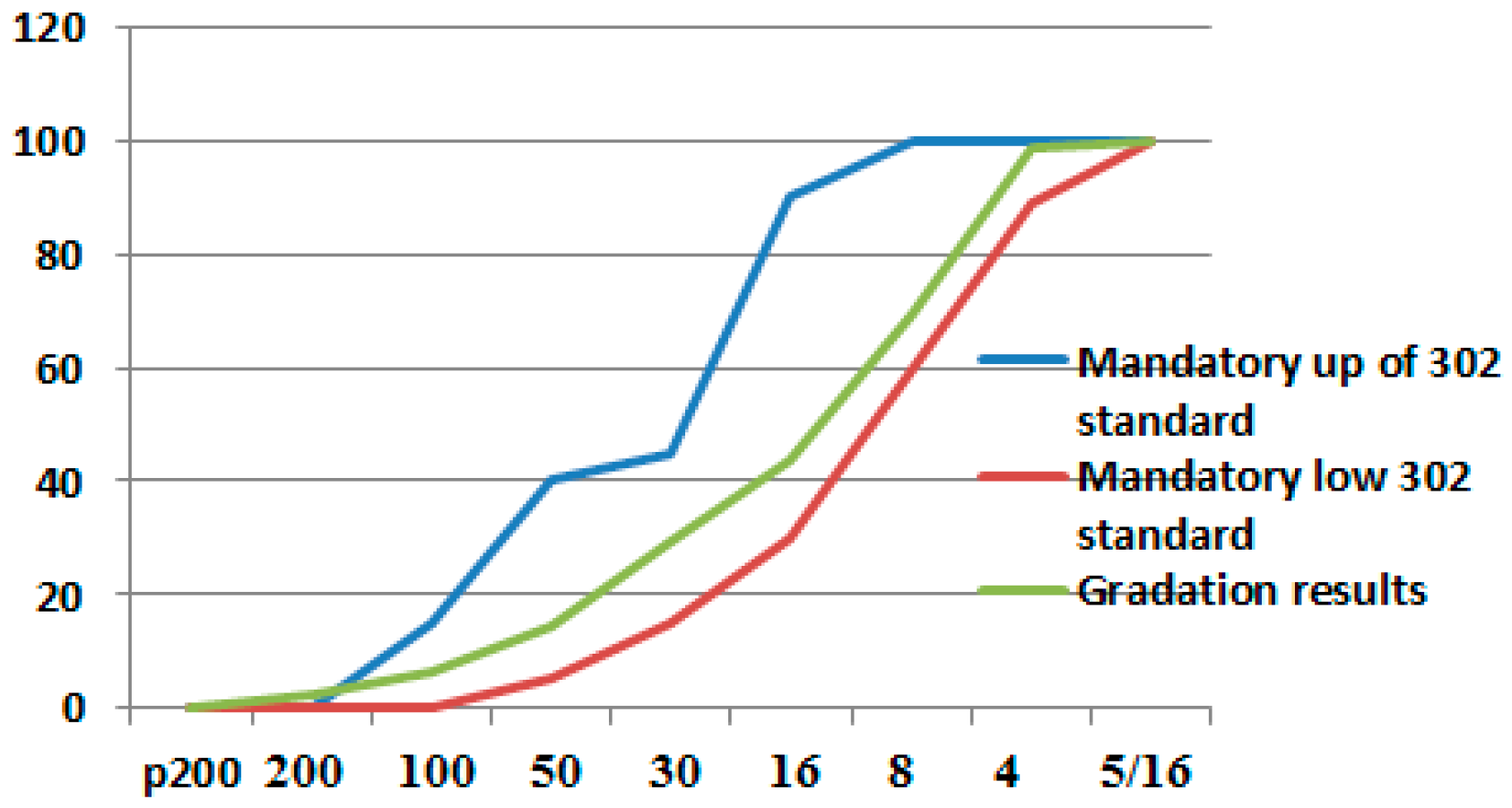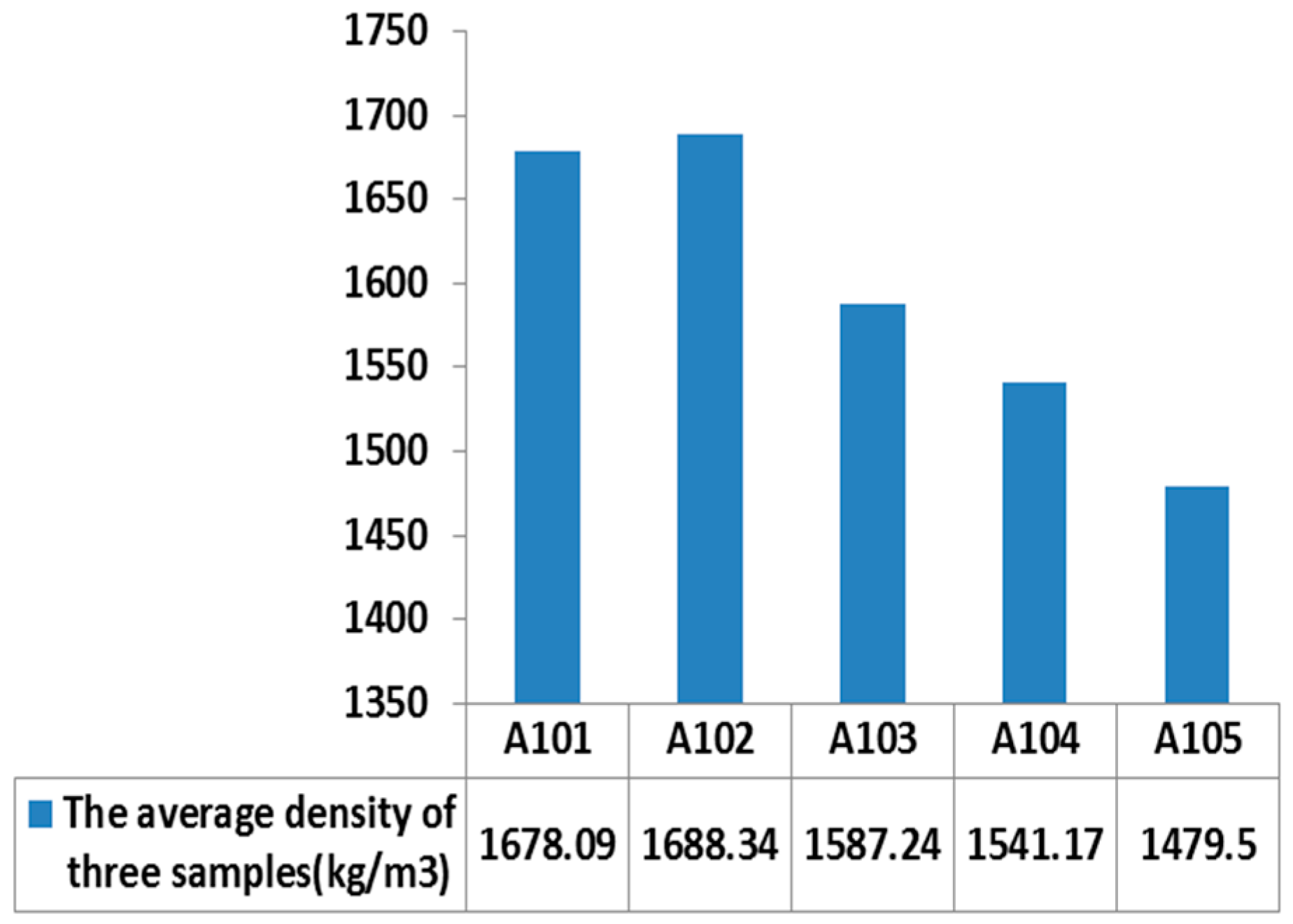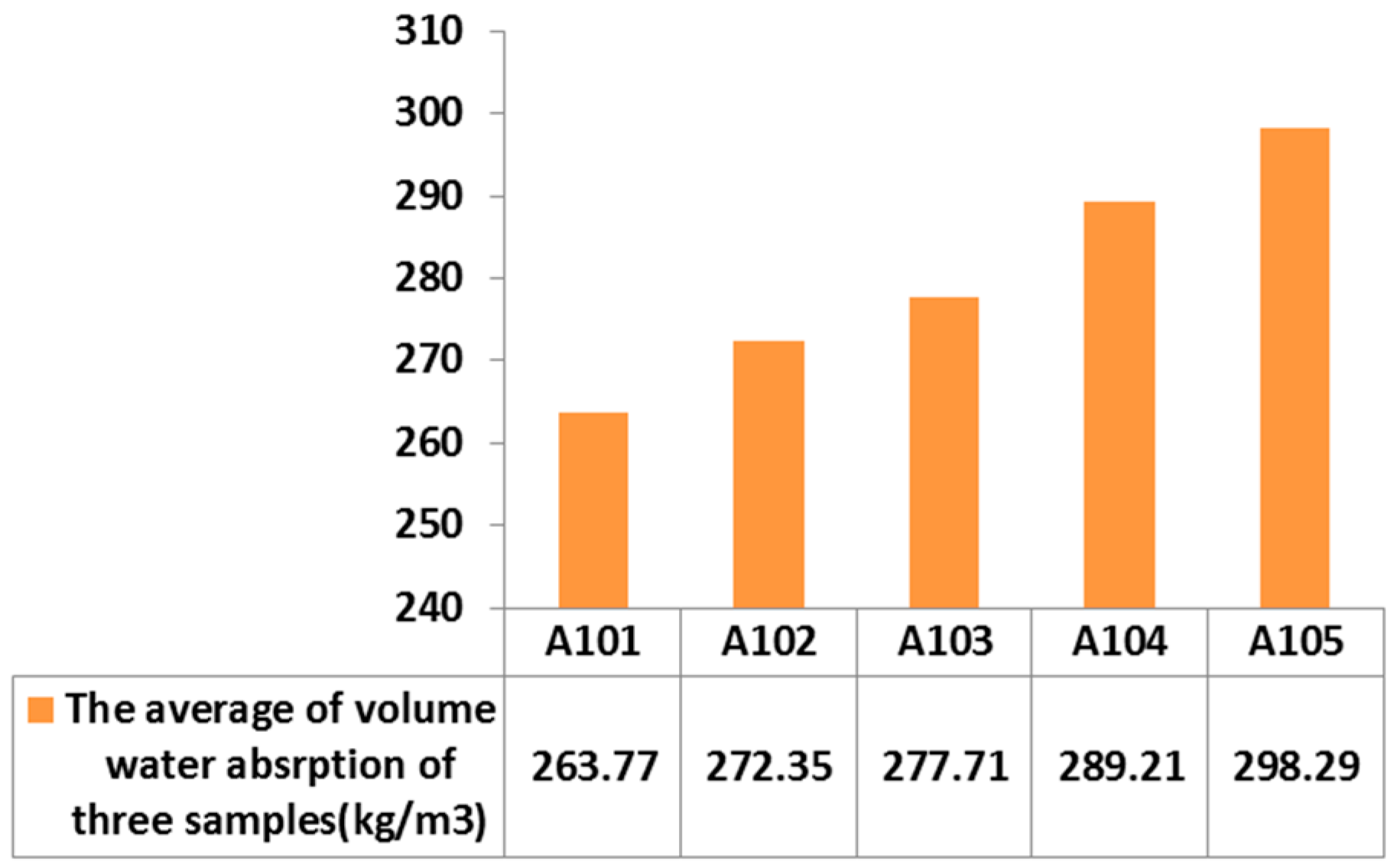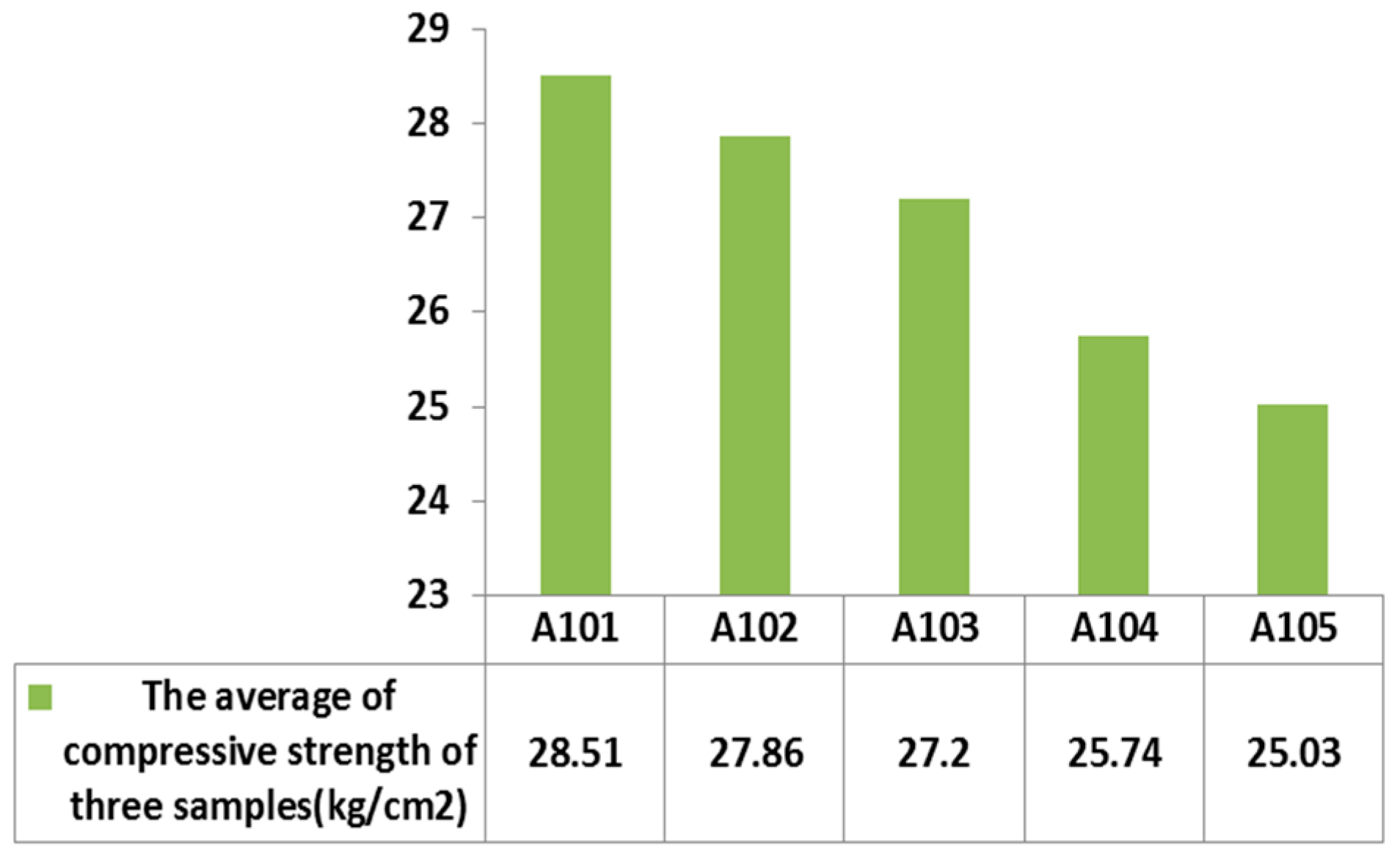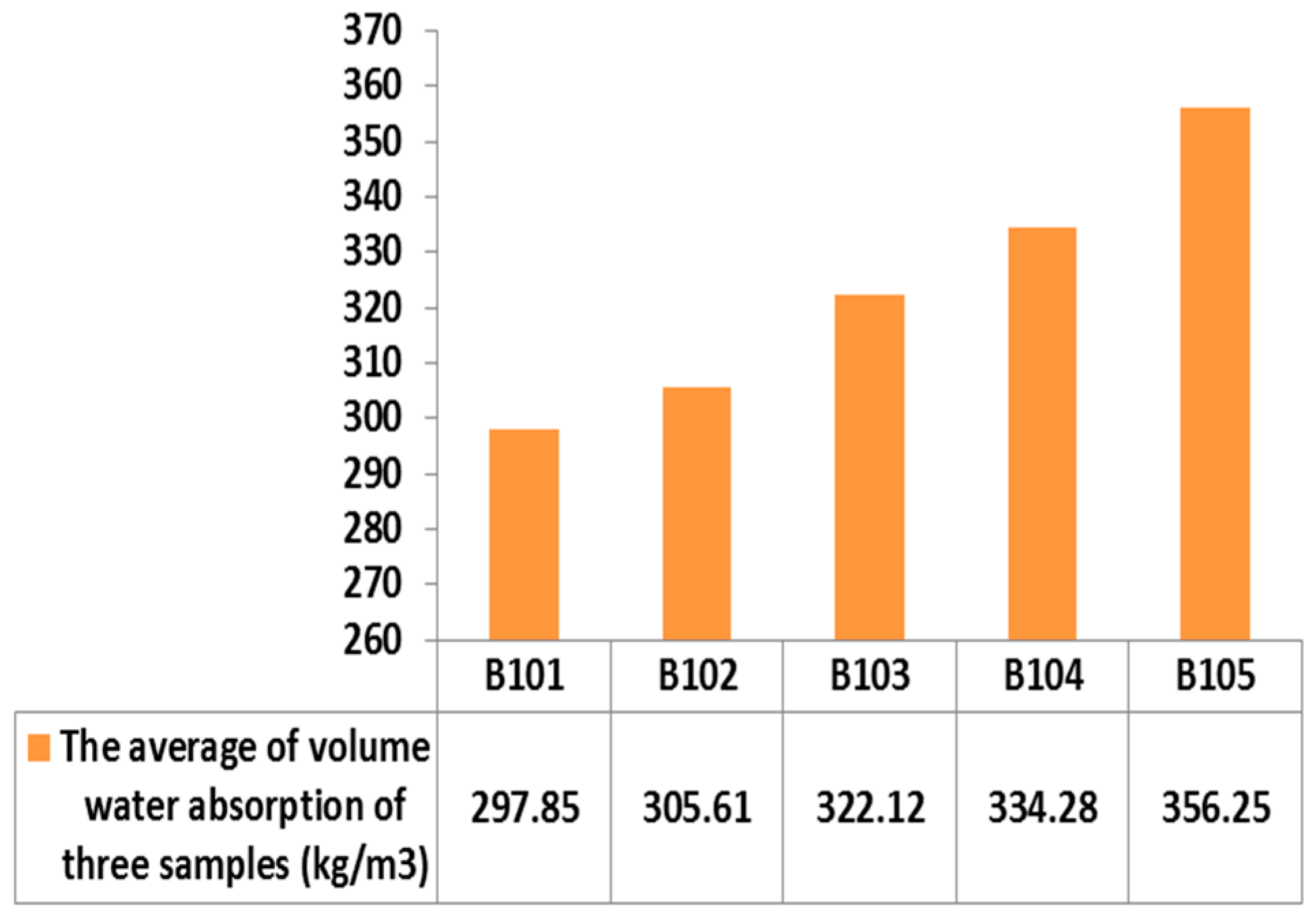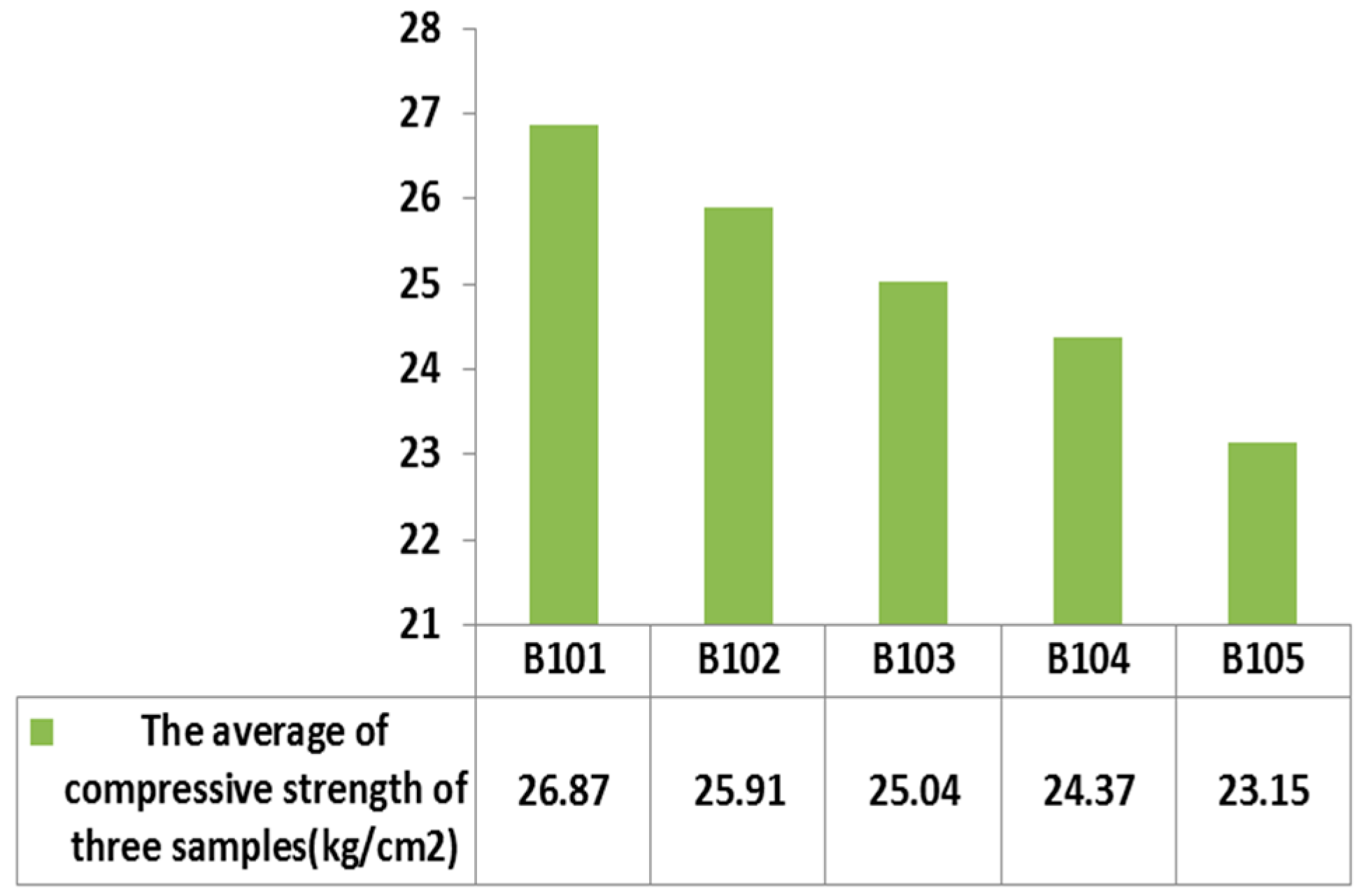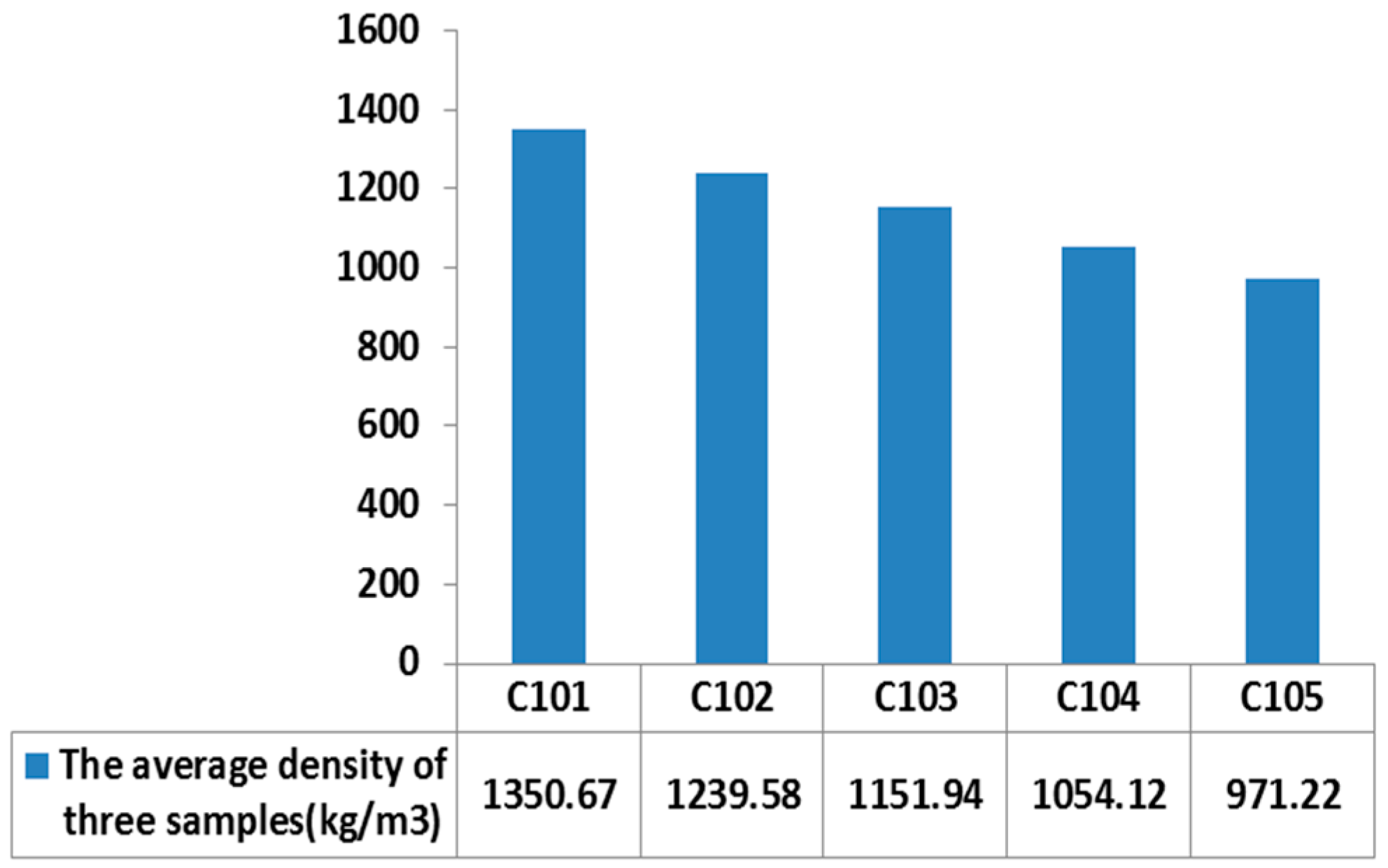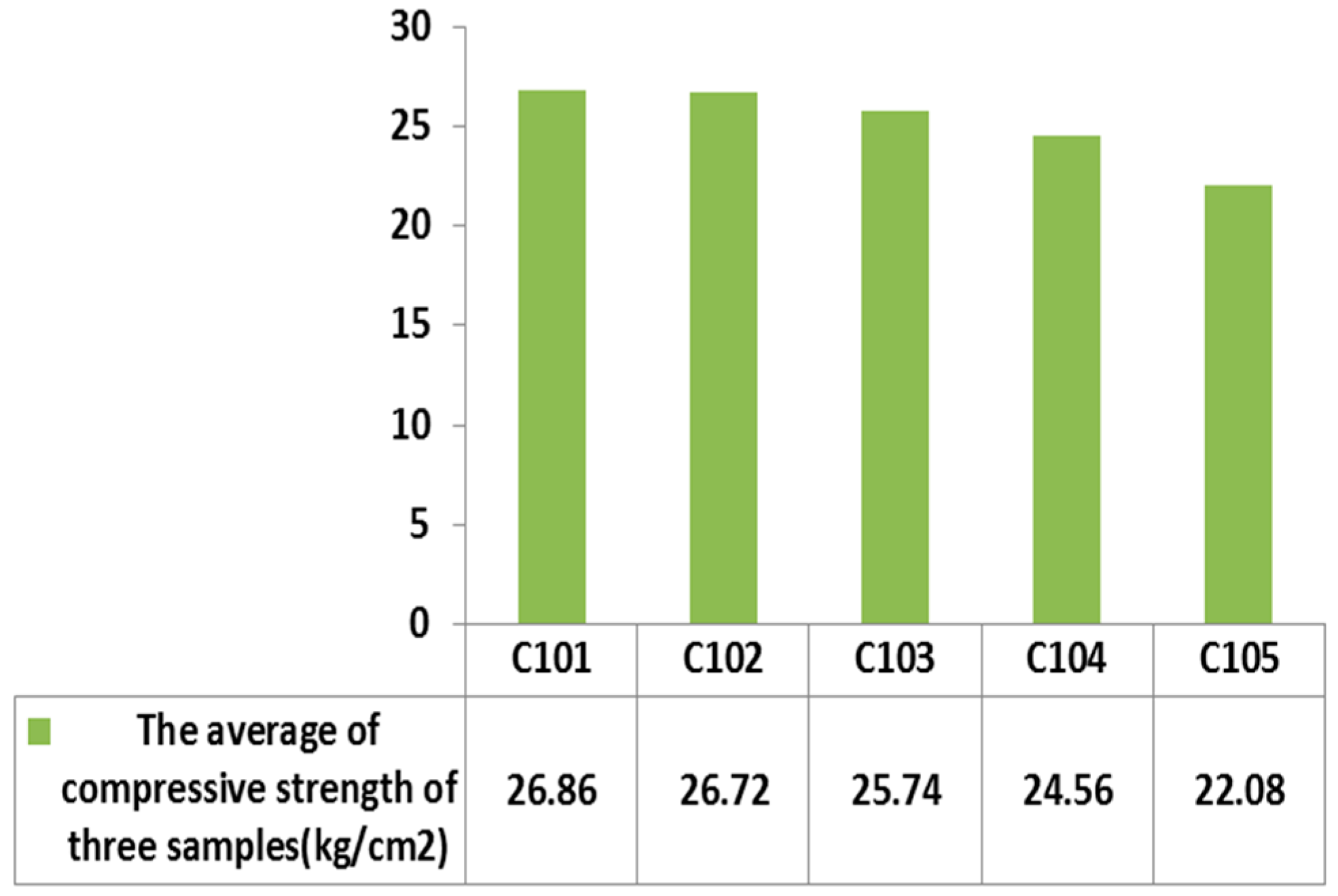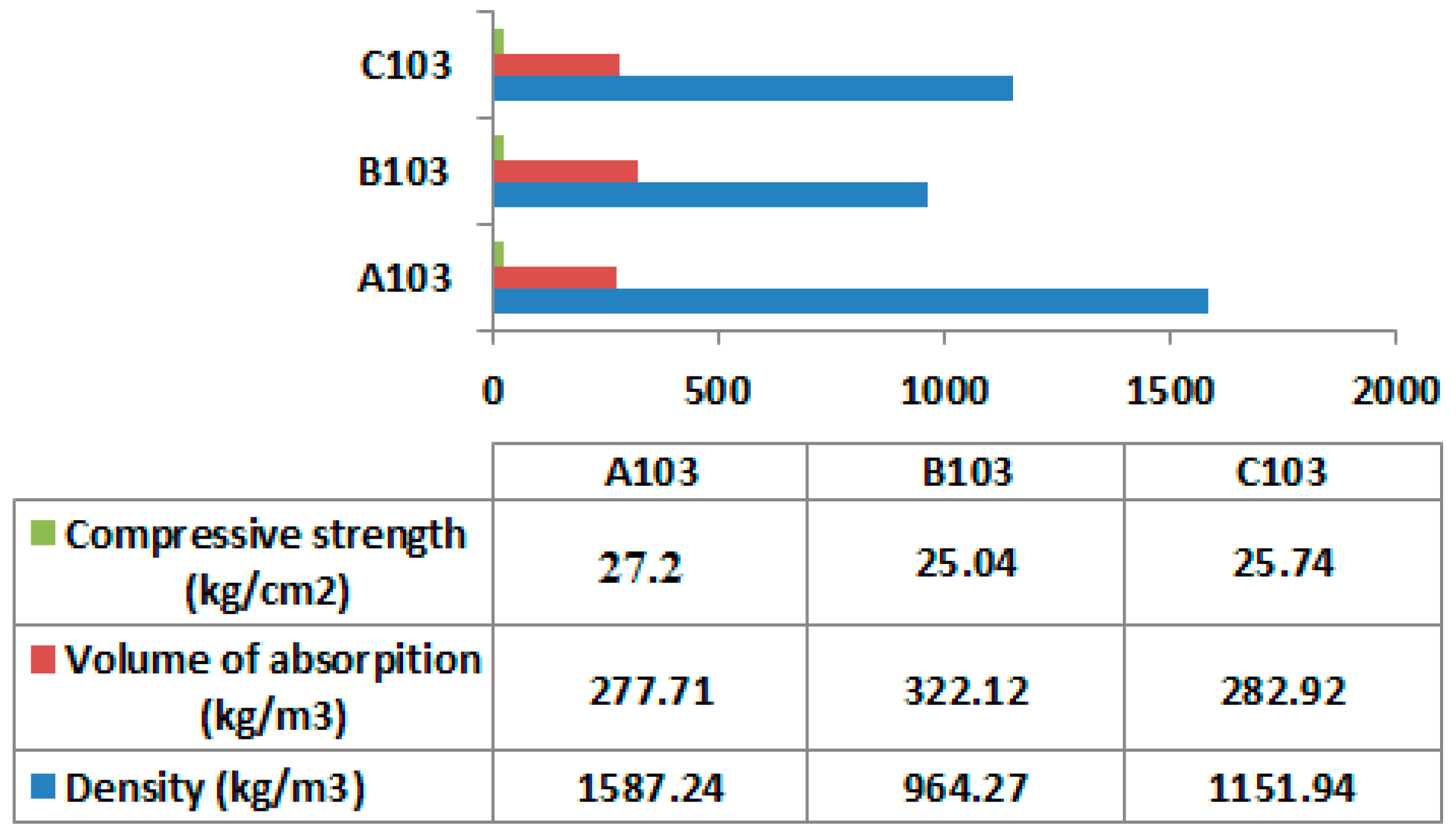2.1. Materials Used
Cement: the use of different types of cements is allowed in the market. The type and amount of cement are determined based on the required properties, usage, and durability. Tehran Portland cement type II (in accordance with ASTM C595) with density of 3150 kg/m
3 and chemical characteristics of
Table 1, according to data quality control of this factory, has been used in this research.
Coarse-grained materials: natural and artificial lightweight aggregates in lightweight aggregate concrete are used instead of coarse grains. Scoria of the Sanandaj, Ghorveh mine with a specific weight of 910 kg/m
3 and grading curve of
Figure 1 (in accordance with
Table 2), as well as Pumice of Tabriz, Bostanabad mine with a specific weight of 685 kg/m
3 and a grading curve of
Figure 2 (in accordance with
Table 3), and light expanded clay aggregate (Leca) of the Tehran Leca company of Iran with a specific weight of 475 kg/m
3 and a grading curve of
Figure 3 (in accordance with
Table 4) have been used to make samples of natural lightweight aggregates.
As it is clear, all grading curves are consistent with the standard of 7657 [
18]. In addition, the chemical properties of consuming lightweight aggregates used have also been presented in
Table 5.
It is worth noting that lightweight aggregates can absorb higher amounts of water compared to aggregates with normal weight, due to their cellular structure. According to ASTM C127 standard (water absorption test defined in 24 h) [
19], lightweight aggregates usually absorb water between 5 to 25 mass percent of dry aggregate depending on their pores’ system. In contrast, most aggregates with normal weight absorb less than 2% of moisture. However, the amount of moisture in a normal weight aggregate depot may increase up to 5 to 10 percent or more. The important difference is that the amount of moisture in lightweight aggregates is absorbed into the grains, as well as on the surface, while the moisture in the normal weight aggregates is mostly surface moisture. This difference is important in the proportion of mixture of batching. Water absorption rate in lightweight aggregates is also impressive in the contribution of concrete mixture, and it depends on the characteristics of the pores of the aggregates. Water absorbed internally in lightweight aggregates is not immediately available for cement and should not be considered as mixing water. On the other hand, almost all of the moisture in natural sand may be surface moisture; thus, it is part of the mixing water.
This shows the necessity of determining the average amount of water absorbed by lightweight aggregates in according to
Table 6.
Fine materials: natural sand used to make samples is sand with a broken format with a density of 2320 kg/m
3 and fineness modulus of 3.39, 24 h water absorption of 3% and chemical characteristics of
Table 7. Grading curve of this sand from
Figure 4 is presented in
Table 8. On the other hand, because of higher fineness modulus and higher resistance that silica sand has in comparison to natural sand, it has also been used to make samples. The silica sand is Qazvin silica sand with a density of 2150 kg/m
3 in according
Table 9, and fineness modulus of 1.50, 24-h water absorption of 23%, and chemical characteristics of
Table 7.
The grading curve of sand becomes out of the optional range defined in the standard of 302 (characteristics of concrete aggregates) [
20], so a broader, mandatory range has been considered.
Water: Drinking water can generally be used in making concrete because of low impurities. Excessive impurity of mixing water not only affects the consumption time and ultimate strength, but it may also cause efflorescence, soiling, the corrosion of bars, volume instability, and reduction of concrete durability. Drinking water has been used in this study.
Superplasticizer: Consumption of these additives increases the fluency of concrete and can reduce the amount of water consumed in concrete, so that concrete fluency remains constant and its compressive strength increases. Superplasticizer from the Fiton company of Tehran of Iran with a density of 1.13 gr/cm3 has been used to make samples according to the catalog.
2.2. Mix Design
The volume method has been used to determine the mix design [
21]. The same mixing method is intended to unify the conditions for making samples and to increase the accuracy of the results of experiments. Using this mixing method, the lightweight aggregates of Scoria, Pumice, and Leca are first poured into a mixer-type blender with two-thirds water for 30 min to reach saturation mode. After this, sand is added to the mixture and mixing operation begins. One-and-a-half minutes after mixing starts, cementitious materials are gradually added to the mixture. After two more minutes, soluble super lubricants are added to the remaining water and the mixing operation continues for two more minutes. Then, samples are produced using a block device.
In addition, in order to treat samples after they are produced, they are preserved for 72 h at 22 °C and humidity of 55%, and, in the end, they are placed in an in vitro environment for 24 h.
Briefly, for every type of lightweight aggregate, five series of projects have been presented with different ratios as the basic projects to reduce density and water volume absorption, and to increase compressive strength as in
Table 10. Other projects have not been mentioned due to similarity in the mixing ratios to each of these projects.
2.3. Experiments
Lightweight aggregate blocks are classified based on density. Thus, three samples of each mix design for the three types of lightweight aggregates of Scoria, Pumice and Leca are soaked in the water for 24 h with temperatures of 16 °C to 27 °C, which are dimensions of 49 cm × 15 cm × 20 cm to become fully saturated. The weight of the immersion mode of samples saturated in water is measured (Wi). Then, they are removed from water and are put on a metal grid with springs of at least 9.5 mm for 1 min until surface water is removed from the samples. After this, visible water is collected with a damp cloth, and the sample is weighted in this state (Ws). Then, the samples are incubated for 24 h at 100 °C to 150 °C and are dried to stabilize weight. Their weights are measured after cooling them down in the air (Wd).
Density is calculated using Equation (1), and its water absorption is obtained using Equation (2) (Standard 70-2) [
22]:
where
D is density in kilograms per cubic meter;
Wd is sample weight after drying in kilograms;
Ws is saturation sample weight in kilograms; and
Wi is saturated sample weight in the case of immersion in water in kilograms.
To conduct a compressive strength experiment, lightweight aggregate block samples must be treated in a greenhouse for 48 h with a maximum relative humidity of 80% at 16 °C to 32 °C, standard (70-2).
To determine the compressive strength of samples, a testing machine must be used. It must be thoroughly cleaned with a speed of 0.5 N/cm2/s. The maximum force on the sample must be noted and divided by the sample surface to obtain compressive strength according to Newton per square millimeter (MPa).


